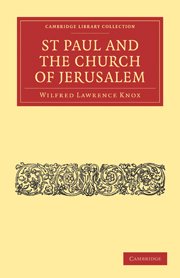Book contents
- Frontmatter
- PREFACE
- Contents
- INTRODUCTION
- Chapter I THE CHURCH OF JERUSALEM
- Chapter II STEPHEN AND SAUL
- Chapter III THE FIRST EXTENSION OF THE CHURCH
- Chapter IV THE ENTRANCE OF THE GENTILES
- Chapter V THE CHURCH AT ANTIOCH
- Chapter VI THE APPEAL TO THE WORLD
- Chapter VII THE COLLECTION FOR THE SAINTS
- Chapter VIII THE END OF THE JOURNEYS
- INDEX
Chapter I - THE CHURCH OF JERUSALEM
Published online by Cambridge University Press: 13 June 2011
- Frontmatter
- PREFACE
- Contents
- INTRODUCTION
- Chapter I THE CHURCH OF JERUSALEM
- Chapter II STEPHEN AND SAUL
- Chapter III THE FIRST EXTENSION OF THE CHURCH
- Chapter IV THE ENTRANCE OF THE GENTILES
- Chapter V THE CHURCH AT ANTIOCH
- Chapter VI THE APPEAL TO THE WORLD
- Chapter VII THE COLLECTION FOR THE SAINTS
- Chapter VIII THE END OF THE JOURNEYS
- INDEX
Summary
At the close of the year 35 a.d. the Christian community in Jerusalem, at that date the only organized body of disciples of Jesus of Nazareth, was enjoying an immunity from persecution which had lasted for several years. The martyrdom of the Founder of the new sect had been rendered possible by a temporary and unnatural alliance between the Pharisees and the sacerdotal party; but the former had refused to continue the policy of persecution after His removal. The reason for the change in their attitude was the fact that His successors showed no tendency to continue that insistence on the radical opposition between the spirit of the new movement and their own devotion to the most scrupulous observance of the minutest details of the letter of Jewish tradition, which had been characteristic of the teaching of the prophet of Nazareth: and it was therefore natural that they should revert to the policy of tolerance which was traditional in their party. It was even to their interest to pursue a policy of patronizing benevolence towards the comparatively small body of “Nazarenes.” They shared the Pharisaic belief in the Resurrection of the dead, and the coming of the Messianic kingdom in a spiritual rather than a purely temporal sense. Further their ethical teaching as derived from Jesus Himself closely resembled, and was to a large extent modelled on, that of the greatest Pharisaic teachers.
- Type
- Chapter
- Information
- St Paul and the Church of Jerusalem , pp. 1 - 38Publisher: Cambridge University PressPrint publication year: 2010First published in: 1925

